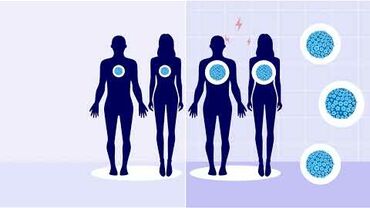Facts about surgical site infections
Overview
Surgical site infections (SSIs) are among the most common healthcare-associated infections (HAIs). The burden of SSIs in the EU/EEA was estimated at 543 149 [95% confidence interval 298 167-1 062 673] cases annually, based on data from the ECDC point prevalence survey of healthcare-associated infections and antimicrobial use in European acute care hospitals 2011-2012 (ECDC PPS). SSIs are associated with longer post-operative hospital stays, may necessitate additional surgical procedures, may require intensive care, and result in higher attributable morbidity and mortality (Cassini et al, 2016). SSIs are also an important target for the surveillance of HAIs and a priority for surveillance in several EU/EEA countries.
The following types of surgical procedures were selected for the surveillance of SSIs in the EU/EEA countries: cardiac surgery, coronary artery bypass graft, cholecystectomy, colon surgery, caesarean section, hip prosthesis, knee prosthesis, laminectomy and rectum surgery.
The ECDC directory of online resources for prevention and control of antimicrobial resistance (AMR) and HAIs contains guidance for the prevention and control of SSIs published by ECDC, EU/EEA countries, international and national agencies and professional societies.
Objectives
The specific objectives of ECDC-coordinated surveillance of SSIs under the Healthcare-Associated Infections surveillance Network (HAI-Net) are:
- To monitor and describe the epidemiology of SSIs in selected surgical procedures in hospitals in EU/EEA countries;
- To assess the burden of SSIs in hospitals in the EU/EEA, in terms of incidence and attributable mortality;
- To prevent SSIs through surveillance by providing EU/EEA reference data for adjusted SSI rates and compliance with key preventive measures, and by providing the hospitals/units with reference data to make comparisons of risk-adjusted rates between units/hospitals:
- to follow-up epidemiological trends over time;
- to identify and follow-up risk factors of SSIs;
- to improve the quality of data collection.
- To compare and follow trends on the level of implementation of key measures to prevent SSIs between hospitals and between EU/EEA countries.
Methodology
Protocol
The ECDC HAISSI protocol for the surveillance of SSIs is based on the surveillance protocol developed by the Hospitals in Europe Link for Infection Control through Surveillance (HELICS) project in 2000-2002. This protocol has been further modified and adapted by ECDC and the national HAI-Net surveillance contact points first in 2010-2012 and then in 2016-2017, with the recent addition of structure and process indicators for the prevention of SSIs.
The ECDC HAISSI protocol comes in two versions:
- Patient-based (or “standard”) protocol: Patient-level data are collected for each patient/operation, whether there is a SSI or not. The data include information on risk factors that allow for risk-adjusted, inter-hospital comparisons.
- Unit-based (or “light”) protocol: Selected patient-level data are only collected for patients with a SSI. Denominator data are collected by operation category (number of operations and postoperative patient-days).
To improve the quality of inter-hospital comparisons, SSI rates must be risk-adjusted so that variations due to differences in patient case-mix are reduced. Therefore, the patient-based (“standard”) protocol remains the recommended method for surveillance of SSIs.
Tools
HelicsWin.Net is a free software application developed by ECDC for the manual entry of HAI surveillance data, including SSIs. Data are stored on the user’s computer until the user chooses to export the data from the software application to, for example, The European Surveillance System (TESSy).
History
2000-2002
Harmonised methods for the surveillance of SSIs were developed by the Hospitals in Europe Link for Infection Control through Surveillance (HELICS) project, funded by the European Commission’s Directorate-General for Health and Consumers (DG SANCO), and progressively implemented in a few EU Member States.
2005-2008
The Improving Patient Safety in Europe (IPSE) project, also funded by DG SANCO of the European Commission, continued the coordination and development of existing national initiatives on surveillance of HAIs, including SSIs, and other approaches to support infection prevention and control in European hospitals.
2008
Transition of SSI surveillance to ECDC under the ECDC-coordinated HAI-Net.
2010
ECDC publishes the first ECDC protocol (v1.01) for surveillance of SSIs on the HAI-Net extranet, on the TESSy website and distributes it to National Focal Points in EU/EEA countries. The protocol is based on the previous HELICS protocol.
The HAISSI record type is included in TESSy.
2012
ECDC publishes the ECDC protocol (v1.02) for surveillance of SSIs on the ECDC website. This version contains minor edits compared to the previous version (v1.01).
2013
ECDC publishes a Systematic review and evidence-based guidance on perioperative antibiotic prophylaxis.
2016
ECDC publishes a directory of online resources for prevention and control of SSIs.
2017
ECDC publishes an updated version of ECDC protocol (v2.2) for surveillance of SSIs, based on the earlier protocols, and including structure and process indicators for SSI prevention.
Publications
- European Centre for Disease Prevention and Control. Surveillance of surgical site infections and prevention indicators in European hospitals - HAI-Net SSI protocol, version 2.2. Stockholm: ECDC; 2017. Available from: https://ecdc.europa.eu/sites/portal/files/documents/HAI-Net-SSI-protocol-v2.2.pdf
- European Centre for Disease Prevention and Control. Surgical site infections – Annual Epidemiological Report for 2015. Stockholm: ECDC; 2017. Available from: https://ecdc.europa.eu/en/publications-data/surgical-site-infections-annual-epidemiological-report-2015
- European Centre for Disease Prevention and Control. Surgical site infections – Annual Epidemiological Report 2016 [2014 data]. Stockholm: ECDC; 2016. Available from: https://ecdc.europa.eu/en/publications-data/surgical-site-infections-annual-epidemiological-report-2016-2014-data
- European Centre for Disease Prevention and Control. Surveillance of surgical site infections in Europe 2010–2011. Stockholm: ECDC; 2013. Available from: https://ecdc.europa.eu/sites/portal/files/media/en/publications/Publications/SSI-in-europe-2010-2011.pdf
- Kärki T, Suetens C on behalf of HAI-Net SSI pilot survey group. Structure and process indicators for the prevention of surgical site infections: results of a European pilot survey [Conference abstract]. Antimicrobial Resistance and Infection Control; 2017, 6(Suppl 3):52; p 21. Available from: https://aricjournal.biomedcentral.com/articles/10.1186/s13756-017-0201-4
- European Centre for Disease Prevention and Control. Surveillance of surgical site infections in European hospitals – HAISSI protocol. Version 1.02. Stockholm: ECDC; 2012. Available from: https://ecdc.europa.eu/sites/portal/files/media/en/publications/Publications/120215_TED_SSI_protocol.pdf



